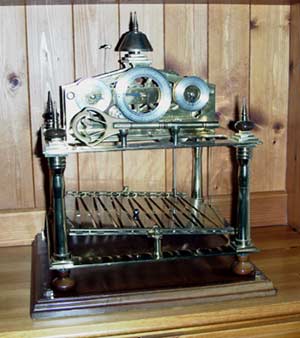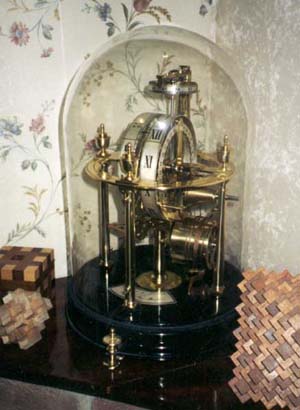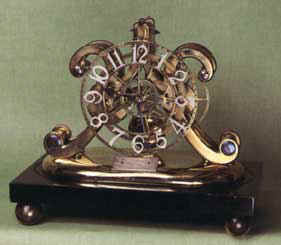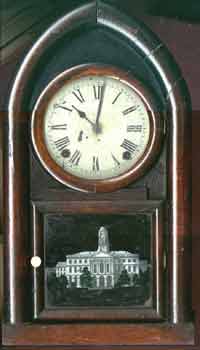Dad's Clocks by...Dad!
My
other love apart from "er" in doors, is clocks, not that I get any time to
make them. I find that the winter is too cold to be standing in the shed
cutting out lumps of brass and steel, I tend to find that my toes drop
off. And in the summer I am too busy doing other things like playing
with the kids, gardening etc.
But over the past years I have
managed to make two clocks, they both don't work properly (and never properly
will) but they look good, The first one I made was the Congreve which
works ok but doesn't keep the time, it also needs stripping down and
re-polishing then re-lacquering and then it would be ok. The second one I
made is the Merlin clock that one goes for a few days at a time then
decides to stop for no apparent reason, I have stripped it down many
times to find the problem but as far as I can see there is no problem,
but it still stops after a day or so. When I first built it, it ran ok, week
after week and month after month then the time that it would run for, got
shorter and shorter. one day I will get it sorted if I'm not too old by
then.
The third one is still in production, (sounds good
that) what I mean is, its in a box in the shed where its been for the past
year now ,I have made all the gear train and front and back plates and
the epicyclic gear, in fact most of it is made, I was about to make the
escapement when I got fed up with it, but I will carry on with it
someday in the next century.


Pictured above is the Congreve
rolling ball clock I made it all made from brass either cut out from sheet
brass or turned from brass rod, it is 13 inches wide by 13 inches deep
and 16 inches high. The clock took me 11
months to make including the case and the making of a wheel cutting
engine, I made everything except the ball bearing.
I managed to make it in such a short time as I spent most evenings in
the shed, much to the wife's annoyance and the other factor of the
short time was I had no kids back then in 1988.
This was the first clock I have ever made and with no knowledge, I
made most pieces 2 or even three times before I got it right and a few
times I go so down in the dumps I nearly gave up.


This clock is the Merlin band clock, it is a worm driven type clock,
it is wound every 8 days. There is a unique way of building this
clock, you must first buy the dome, then turn the wooden base to fit the
dome, this is because the clock doesn't have a front and back plate like
most clocks, its plates are firstly the top ring that you can see in the
photo and then the wooden base is the equivalent of the back plate held
apart by the 5 pillars. When making the base you must first acquire the
wood and before mounting it in a lathe you slice the wood up into 1 inch
strips, then reverse every other strip then you stick it back together
again, this is done to prevent any warping in the wood. When I made
this clock I had troubles all the way and I now find it hard to believe
that the original clock made by Merlin was done so in the 17th century
without any electricity and power tools etc.


This clock is not finished yet and this is what it will look like (I
hope). The unique feature of the Strutt epicyclic geared clock is the train of gears which
involve using sun and planet wheels, by this I mean that there is a
large ring that is situated behind the dial and it has teeth on the inside
of the ring that is driving a planet wheel that instead of revolving
like normal gears do, this one rolls around the inside of the ring once
every 20 minutes in the picture you can see the planet wheel if you look
carefully its at the three o'clock position.


This next example
is one that I have been given and not made. It was very kindly given
given to us by a friend of Carol's Granddad. We know its an American
shelf clock and was made about 1850 by J.C. Brown who was a clock maker in
Bristol, Connecticut U.S.A. The house on the front of the clock was the
original Hartford State House it was built in 1796 and was used until Connecticut's
Capitol Building was built in 1878.
